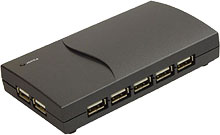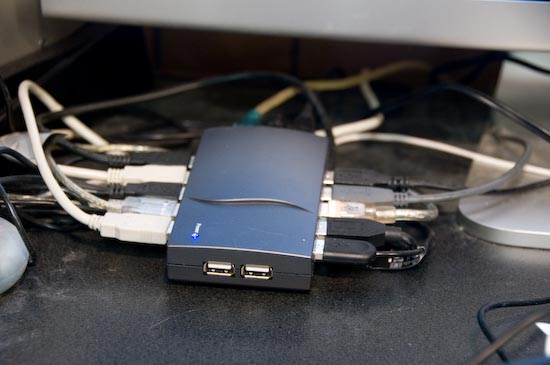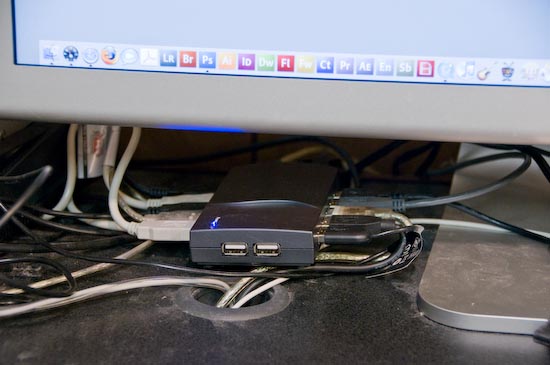
You may remember that I put out a call to the readers of this blog for recommendations on a good USB hub. Most readers came back with Belkin as a suggestion and well, I took your suggestions and standardized on Belkin USB 2.0 hubs throughout my house. In most cases the Belkin 7 port USB 2.0 hub provided enough ports for most of the computers in my house. However, my main production desktop computer (Mac Pro) has a LOT of peripherals attached. On this one Mac I have a USB scanner, Bravo Pro DVD duplicator, SoundSticks USB digital speakers, Epson R1800 Printer, Wacom tablet, Epson P3000 Multimedia drive, Maxtor Hard Drive, ShuttlePro 2 video controller, SanDisk 12-in-1 Card Reader, APC BackUPS, Griffin PowerMate, 3D Space Navigator, NuLOOQ Navigator, USB keyboard and mouse. Yes, I’m a peripheral junkie, but you knew that. With this many USB devices I had to string 3 Belkin hubs together just to have enough ports to plug in all my gear.

Although this solution worked, it was not ideal. There would be times where the last two hubs wouldn’t wake up when the Mac Pro woke up from sleep. While this was rare, it was still frustrating. It generally meant that I would have to unplug and re-plug the last two hubs back in.
Well the good folks at Synchrotech have come through for me once again. They make a 13 port USB 2.0 hub. That’s right! This one hub expands one of your USB 2.0 ports into 13 ports. So I was able to replace my 3 Belkin hubs with one 13 port hub.

While this hub provides me with enough ports (I have one left over now), there is one issue and that is the design of the hub itself. I’m not a fan of the "octopus design" where cables are coming out from all sides. The AC adapter, USB to Computer port and a single USB port are on the back. Then you have five USB ports on both sides and two in the front. This can make your desk look even messier. However, there is no requirement that the hub actually reside on your desk. So if the sight of cable clutter bothers you, simply relocate the hub under your desk. In my case I still like having access to the two front USB ports, so I simply relocated the hub under my Cinema Display. Now it’s time to do some dusting 🙂

If you have two or more hubs that you would like to consolidate down to one, then I highly recommend the Synchrotech 13 port USB 2.0 Hub. It’s $45 and comes with a USB cable to attach to your computer as well as the AC adapter to provide power.


You seem to be high on Synchrotech products of late. I’m still considering the firewire CF card reader you reviewed earlier.
I agree that the octopus look is a little unbecoming. It would be cool to see a version with 10 ports on the back and then three in front for more occasional use…like for a portable drive.
Why oh why oh why can’t EveryDernThang be wireless? My desk looks like a Ronzoni factory. I think I’ll get one of these, but there will still be pesky wires everywhere. Sigh.
Doesn’t an approach like this severely limit the USB throughput? You are taking one 480mbs connection and sending 13 devices through it. Most of Terry’s gadgets should be fairly low throughput, but having a DVD duplicator and hard drive attached would seem to be asking for trouble. Is this correct or just old school thinking on my part? Would you be better off connecting 3 five-port USB hubs to three separate USB connections on the computer and spreading out the high bandwidth devices?
Jeff,
I posed your very good question to the folks over at Synchrotech and here’s what they said:
You are absolutely right on this. This hub is for people attaching mostly lower end USB 2.0 devices. Two higher performance device like hard drives or optical media devices will probably (not always) saturate a single USB port. That said, most of the time people aren’t using these kind of devices concurrently. You just might be fine with both the drive and the DVD duplicator running at once (let us know), but we wouldn’t recommend any more demanding devices at the same time than two. However, if guaranteed throughput for a higher performance device is needed, it is best to connect them directly to a host port.
The other issue is power. While the 13 port hub provides 4 Amps, that wouldn’t be adequate for 13 devices drawing between 500-600mA each. However, we designed this for typical users that might have between 2 to 3 USB devices pulling a lot of current, and the rest pulling nominal current.
This is not related to the review of the USB hub per se but to the problem of external devices not appearing when waking from sleep (“There would be times where the last two hubs wouldn’t wake up when the Mac Pro woke up from sleep.”).
I have found that if you restart the Finder when this occurs (by Option-click-n-hold on the Finder icon in the Dock and then choose “Relaunch”) that this usually solves the problem without having to unplug and then re-plug in the devices.
Although this one only has 7 ports, I find it to be helpful with cable clutter. It is the Kensington DomeHub.
http://us.kensington.com/html/6495.html
This looks very handy I am always running out of usb ports.
It seems every thing has got a usb connecter on it nows days.
Let me add my reality check. My humble iMac G5 has THREE USB 2.0 ports on board. I use the ‘dome’ Kensington 7-port hub to connect (1) an HP scanner, (2) an iPhone, (3) an iPod, (4) a Mighty Mouse, (5) a Motorola USB cell phone and (6) an Apple Keyboard. I still have an on-board USB plus one external to spare.
Four external LaCie drives, DVD-RW and hard drives are on FireWire, printer on Ethernet, and small external speakers are on the mini-stereo. I don’t see a need for a 13-port hub now or in the future.
BTW, I don’t see wire clutter ‘cos the ‘dome’ is behind and below the iMac flat-panel screen, sort of out of sight.